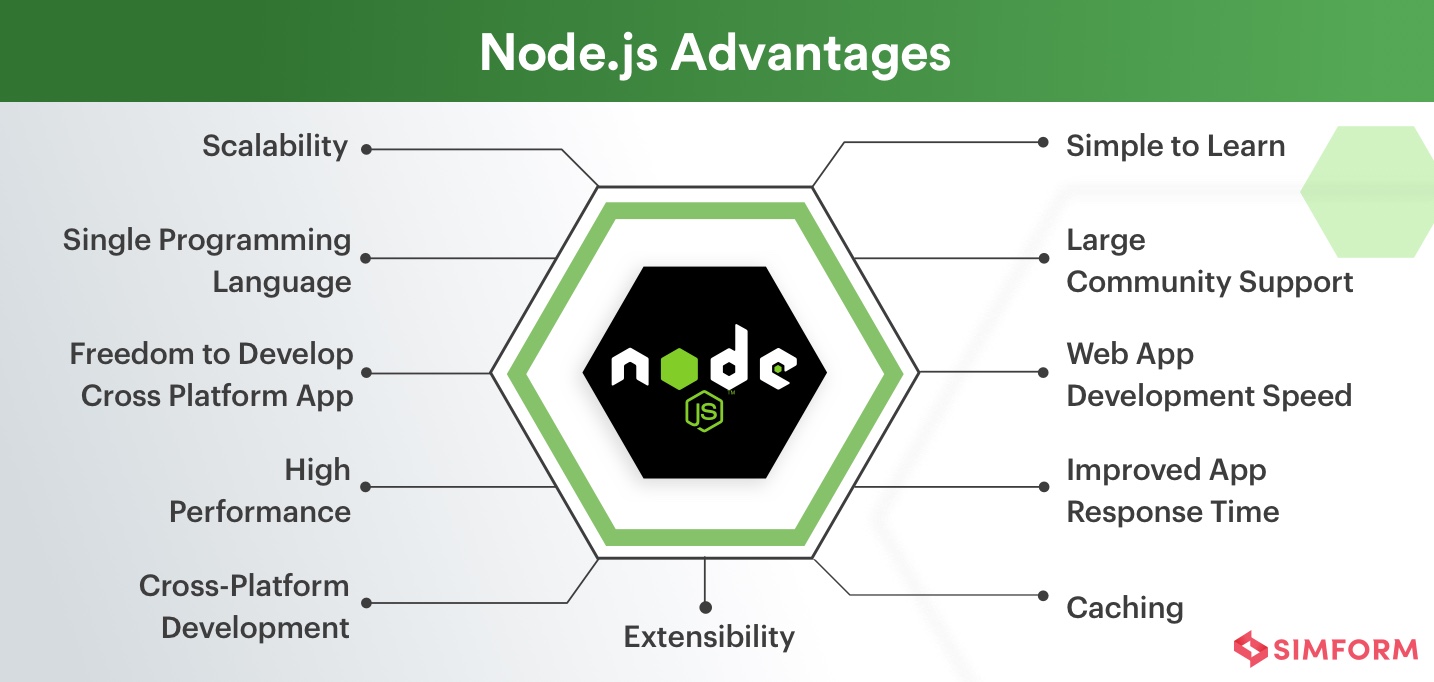First Class Tips About Why Is Node Used

Unraveling the Mystery
1. The Allure of Node
Ever wondered why seemingly everyone's talking about Node.js? It's not just a fleeting tech trend, but a robust platform that has significantly reshaped how we build web applications. Node.js, at its core, is a JavaScript runtime environment built on Chromes V8 JavaScript engine. Think of it as the engine that powers your car, but instead of driving you around, it's driving your applications.
What makes it so appealing? Well, for starters, it allows developers to use JavaScript on both the client-side (what you see in your browser) and the server-side (the behind-the-scenes stuff). This "JavaScript everywhere" approach streamlines development. No more switching between different languages and mindsets. Imagine trying to explain to someone why you need to speak two totally different languages just to build a simple website. Node.js solves that problem.
But there's more to the story than just JavaScript consolidation. Node.js's non-blocking, event-driven architecture is key to its performance. What does that mean in plain English? It means Node.js can handle multiple tasks simultaneously without getting bogged down. It's like a skilled juggler who can keep many balls in the air without dropping any. Other server-side languages might get stuck waiting for one task to finish before moving on, but Node.js gracefully keeps things moving.
Another HUGE advantage? The sheer size and vibrancy of the Node.js community and its npm (Node Package Manager) ecosystem. npm is like a giant online store filled with reusable code packages that you can easily incorporate into your projects. Need a module to handle authentication? There's an npm package for that. Want to generate PDFs? Yep, there's a package for that too! This massive collection of pre-built components significantly speeds up development, allowing you to focus on what makes your application unique. So, instead of reinventing the wheel, you can just grab a ready-made wheel from npm and get rolling!

The Power of Asynchronous Programming
2. Non-Blocking I/O
Let's delve deeper into the asynchronous nature of Node.js. Traditional server-side languages often use a synchronous, blocking model. This means that when a request comes in, the server processes it sequentially, waiting for each step to complete before moving on to the next. Imagine a single cashier at a busy coffee shop. If one customer has a complicated order, everyone else has to wait. Not ideal, right?
Node.js, on the other hand, employs an asynchronous, non-blocking I/O model. Instead of waiting for an operation to finish, Node.js kicks off the operation and moves on to handle other requests. When the operation completes, Node.js uses a callback function to process the result. Back to our coffee shop analogy, imagine multiple baristas handling different parts of each order simultaneously. One barista might be steaming milk while another is pulling shots of espresso. This allows the coffee shop (or your server) to handle more customers (or requests) concurrently, leading to increased throughput and responsiveness.
This is particularly beneficial for real-time applications like chat applications, online games, and streaming services. Imagine trying to play an online game where every action you take requires the server to pause and process it before allowing you to continue. Frustrating, isn't it? With Node.js, the server can handle many concurrent game players without lagging, resulting in a smoother, more enjoyable experience.
But what about errors? Handling errors in asynchronous code can sometimes be tricky, but Node.js provides mechanisms like callbacks, Promises, and async/await to make error handling more manageable. These tools allow developers to gracefully handle errors and prevent them from crashing the entire application. Think of it as having a system in place to catch spilled coffee before it ruins everything!

Real-World Applications of Node.js
3. From Startups to Enterprises
It's all well and good to understand the theory behind Node.js, but what about real-world examples? You might be surprised to learn how many well-known companies are using Node.js in their production environments. Companies like Netflix, Uber, LinkedIn, and Walmart have all adopted Node.js for various aspects of their infrastructure.
Netflix, for example, uses Node.js for its user interface and some of its API services. They chose Node.js because of its performance and scalability, which are critical for handling millions of streaming requests every day. Uber relies on Node.js for its matching service, which connects drivers with passengers. The real-time nature of Node.js makes it a perfect fit for this type of application.
LinkedIn uses Node.js for its mobile app and its server-side infrastructure. They found that Node.js allowed them to develop and deploy applications faster, improving their time to market. Walmart leverages Node.js for its mobile app and its e-commerce platform. The ability to handle high volumes of traffic is essential for an e-commerce giant like Walmart, and Node.js delivers on that front.
But it's not just big companies that are using Node.js. Many startups and small businesses also use Node.js because of its ease of use and the availability of a large talent pool of JavaScript developers. Whether you're building a simple website or a complex web application, Node.js can be a powerful tool in your arsenal.

The Downsides and Alternatives
4. No Technology is Perfect
While Node.js offers many benefits, it's not a silver bullet for every situation. One potential downside is that Node.js is single-threaded. This means that CPU-intensive tasks can potentially block the event loop, impacting the overall performance of the application. However, this can be mitigated by using worker threads to offload CPU-intensive tasks to separate threads.
Another potential challenge is the callback hell that can sometimes arise when dealing with complex asynchronous operations. Fortunately, Promises and async/await provide more elegant ways to handle asynchronous code and avoid the nested callback structure. It's important to use these tools effectively to write clean, maintainable code.
In situations where performance is absolutely critical, or when dealing with highly complex and CPU-intensive tasks, other languages and platforms like Java, Go, or Python might be more appropriate. Java, with its robust threading model and mature ecosystem, is often a good choice for enterprise-level applications. Go, with its concurrency features and efficient memory management, is well-suited for building high-performance network services. Python, with its extensive libraries and frameworks, is a popular choice for data science and machine learning applications.
Ultimately, the best technology depends on the specific requirements of your project. It's important to carefully consider the pros and cons of each option before making a decision. Just like you wouldn't use a hammer to screw in a screw, you wouldn't necessarily use Node.js for every single type of application. Choose the right tool for the job!

Advantages & Disadvantages Of Node.js Why To Use Node.js?
Getting Started with Node.js
5. Diving In
Okay, so you're convinced that Node.js is worth a look. Where do you start? The first step is to download and install Node.js from the official website (nodejs.org). Once you have Node.js installed, you can verify the installation by opening your terminal and running the command `node -v`. This should display the version number of Node.js that you installed.
Next, you'll want to familiarize yourself with npm (Node Package Manager). npm comes bundled with Node.js, so you don't need to install it separately. You can use npm to install packages, manage dependencies, and run scripts. To install a package, you can use the command `npm install `. For example, to install the popular Express web framework, you would run the command `npm install express`.
There are tons of great resources available online for learning Node.js. Websites like freeCodeCamp, MDN Web Docs, and Node.js.org offer comprehensive tutorials and documentation. You can also find many helpful videos and courses on platforms like YouTube and Udemy. Don't be afraid to experiment and try out different things. The best way to learn is by doing!
Start with small projects and gradually increase the complexity as you become more comfortable with the platform. Building a simple web server, a command-line tool, or a basic API are all good starting points. Remember, everyone starts somewhere, and with a little practice, you'll be building amazing things with Node.js in no time!

Why Use Node Js? 5 Reasons To Node.js For Your App
FAQ
6. Frequently Asked Questions about Node.js
Q: Is Node.js a language or a framework?
A: Neither, exactly! Node.js is a runtime environment for executing JavaScript code server-side. It leverages the V8 JavaScript engine (the same one used by Chrome) and provides a set of built-in modules for interacting with the operating system, file system, and network. While you use JavaScript to write Node.js applications, Node.js itself isn't a language. Frameworks like Express.js are built on top of Node.js to provide structure and conventions for building web applications.
Q: What is the main advantage of using Node.js?
A: One of the biggest advantages of Node.js is its asynchronous, non-blocking I/O model. This allows Node.js to handle many concurrent requests efficiently without getting bogged down. This makes it a great choice for real-time applications and applications that require high performance.
Q: Is Node.js suitable for CPU-intensive tasks?
A: While Node.js excels at I/O-bound tasks, it's not always the best choice for CPU-intensive tasks. Because Node.js is single-threaded, CPU-intensive tasks can potentially block the event loop and impact performance. However, you can use worker threads to offload CPU-intensive tasks to separate threads and avoid blocking the event loop.
Q: How does Node.js compare to other server-side languages like PHP or Python?
A: Node.js offers several advantages over traditional server-side languages. Its event-driven architecture provides higher performance and scalability. Furthermore, using Javascript on both front and back end can allow for faster development cycles and reuse of code between the client and server. However, PHP is still widely used and easy to deploy and Python is good for machine learning and back end.